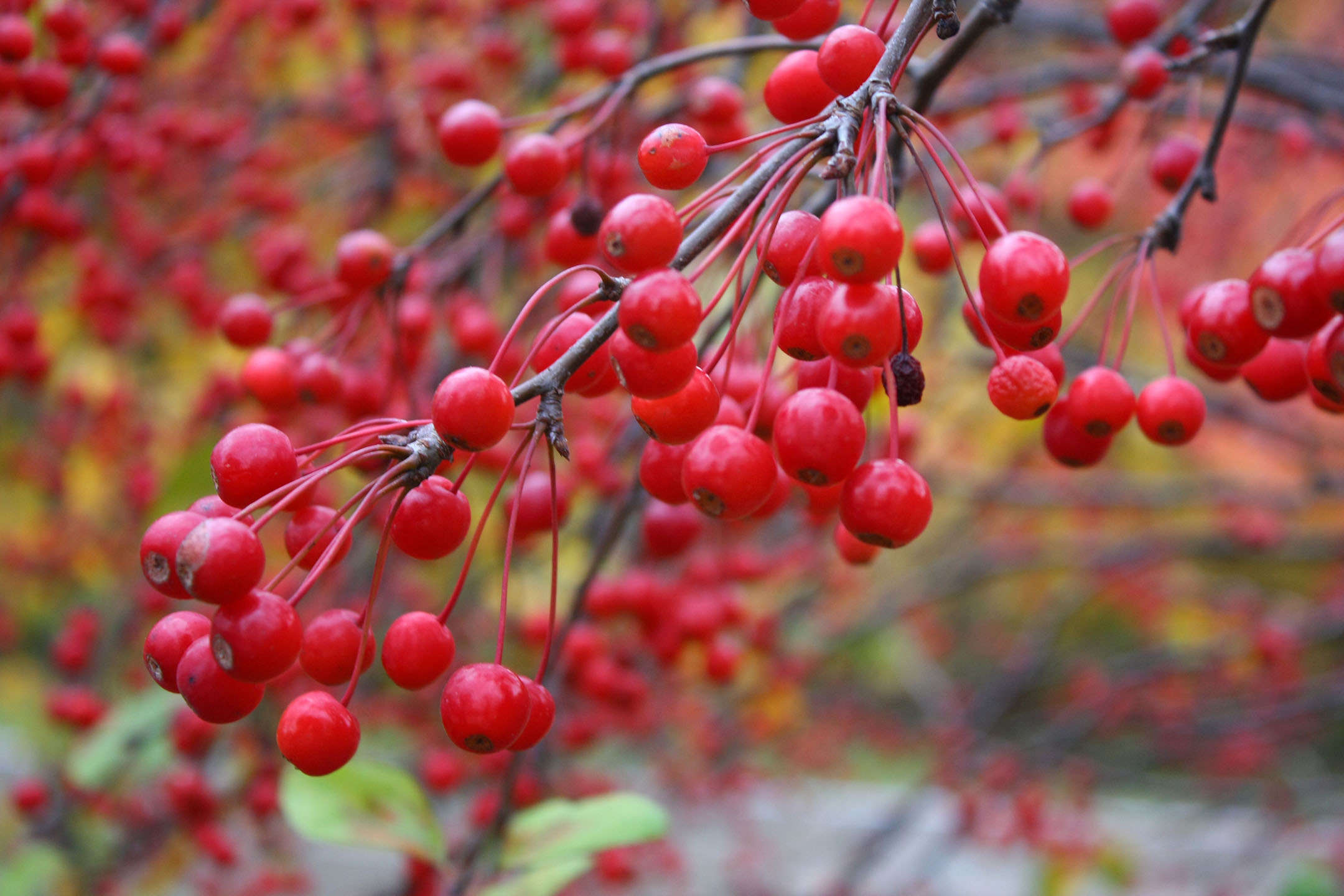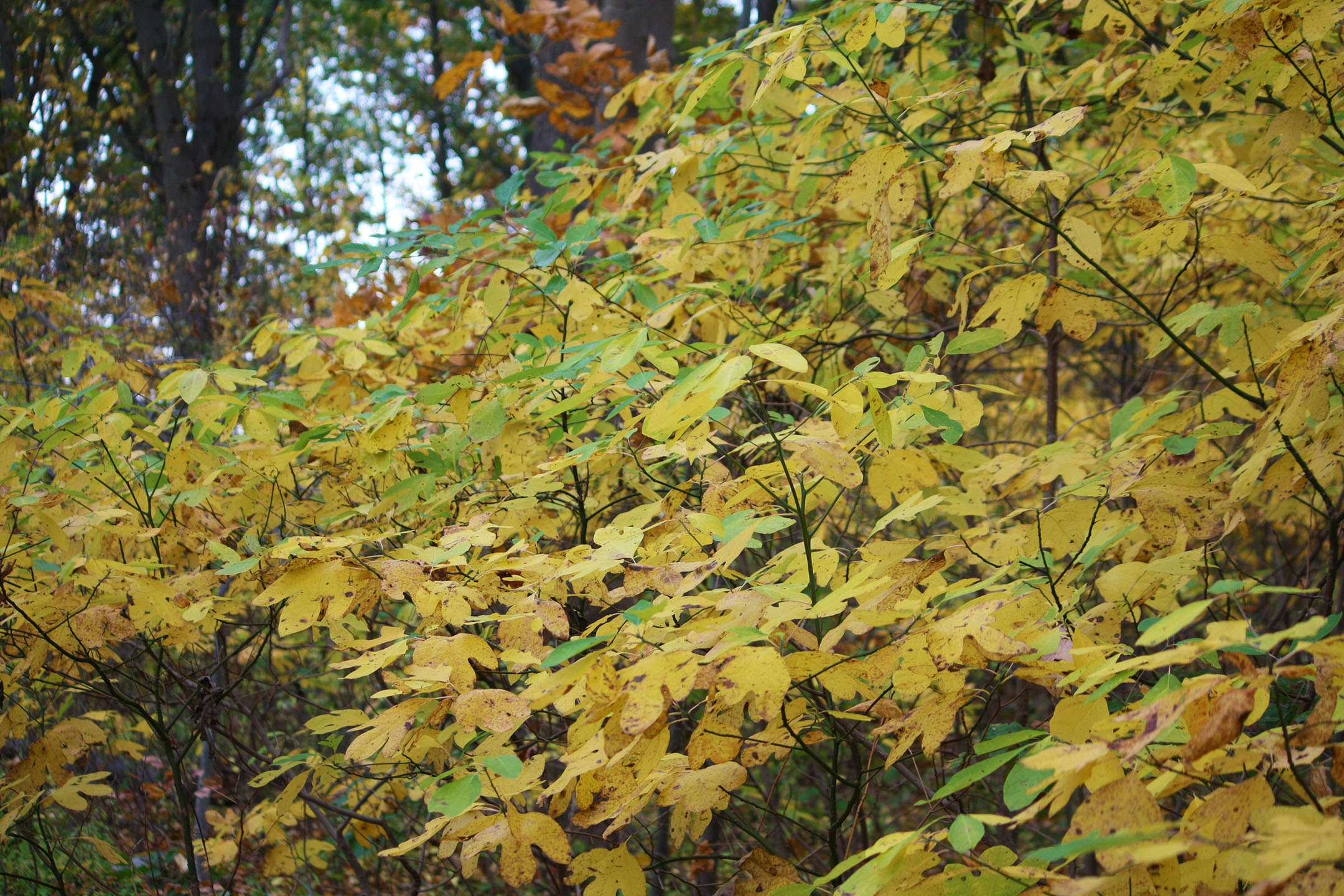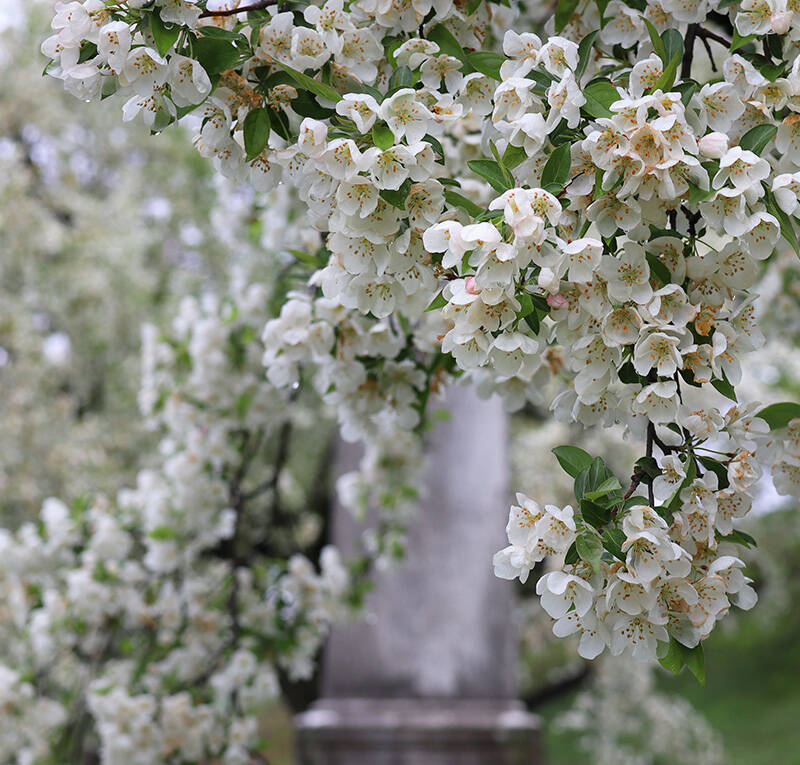When planning gardens we often think about form and about blossoms, in terms of trees, but not about what happens next. Fall color is an added and symbolic seasonal domestic pleasure at a time when New England and the forests of the Northeast are blazing with it. Here is a collection of 11 trees which turn gorgeous when the air begins to nip.
Photography by Marie Viljoen except where noted.

Above: A warm glow from a well-chosen selection of autumn-interest trees adds complexity and depth to the picture that is a garden.
Crabapple

Above: Crabapple trees are overlooked as autumn contenders; we usually think only of their spring blossoms with their fresh-snow scent. But when cold weather arrives the right cultivar (try ‘Adams’, or try ‘Calocarpa’) will make the neighbors think you are growing your own maraschino cherries. The fruit lights up the bare branches like Christmas ornaments and persists through the most intense months of winter, also providing food for passing and hungry birds.
Crepe Myrtle

Above: Photograph by Bron Praslicka via Flickr.
Crepe myrtles (Lagerstroemia indica) turn a shocking orange in fall (when planted in full sun), bridging their other two seasons of interest: summer’s lush bunches of flowers, and winter’s smooth bark on sinuous branches, exposed after the bright leaves have fluttered down. They are medium to small trees and good for large containers and small gardens.
Hawthorn

Above: Better known for their posies of scented blossom in mid spring, hardy hawthorns (Crataegus species and cultivars)are yellow and russet beacons in autumn, displaying fiery bunches of berries in ornamental clusters which last well into the new year. Try their ripe fruit in jellies and fruit leathers.
Black Locust

Above: If you have the space for a statuesque tree, the indigenous black locust (Robinia pseudoacacia) is a fall-gorgeous choice. Following many months after the sweetly scented (and edible) mid-spring flowers, the compound leaves are like yellow feathers on the tree and turn the ground beneath into a magic carpet when they fall.
Redbud

Above: Demure denizens of eastern North American forest edges, redbuds (Cercis canadensis) light up for fall. Their large, heart-shaped leaves become brilliant yellow, and transform the small trees into bright umbrellas after the first frost. This is the perfect tree for shade or semi-shade, and a small garden.
Rowan

Above: A native of the Northeast, the little-used rowan, or mountain ash (Sorbus americana), is a striking choice for any garden spot with full sun. Large bunches of amber berries (they make excellent jellies and cordials) ripen from late summer and are later backlit by the crimson compound leaves. Ask for this tree at a native plant nursery. It deserves to be better known.
Sassafras

Above: Sassafras (Sassafras albidum)roots used to be the source of the flavor in rootbeer, and if you crush their fragrant wide leaves a vintage float is exactly what you smell. The powdered green leaves make the Creole gumbo-thickener, filé. But even if you do not eat them, plant sassafras for its rich copper fall attire, which blazes along shady garden edges.
Serviceberry

Above: It is hard to say enough about serviceberries (Amelanchier species). Another North American native, the only time this tree goes silent is in winter. After dainty spring bloom and early summer fruit (which look like red blueberries and taste like sweet apples), the leaves of these multi-stemmed small trees and shrubs gradually begin to smoulder, each leaf’s ribs etched in yellow on a red-hot background.
Spicebush

Above: In his book Native Trees, Shrubs, and Vines (Houghton Mifflin Harcourt, 2002), William Cullina, director of the Maine Coastal Botanic Garden, writes that spicebush (Lindera benzoin) “has a wild elegance about it that is perfect at the edge of the woods or scattered through trees.” It is one of the earliest shade-loving trees to flower after winter. In the fall female trees bear berries like red drops hanging among the yellow leaves (the berries are known as Appalachian allspice and are used in cooking. Crush the twigs of the tree to smell its citrus-pine scent.)
Witch Hazel

Above: The native witch hazel (Hammamelis virginiana) does two wonderful things at once: it blooms and turns at the same time. In mid fall the flowers hang like yellow threads beneath crisping golden leaves. Imported witch hazel cultivars from Asia also deliver excellent autumn interest, whiletheir flowers appear in late winter. Grown in full sun to dappled shade, they are smart choices for small gardens.
Zelkova

A late fall walk under the same avenue of zelkovas (Zelkova serrata) you have seen every day for the last year will stop you in your tracks. What is that tree? Until November, you don’t notice they’re there – and then they begin to burn. These vase-shaped street trees are among the most brilliantly colored in autumn and warrant a spot in a large, sunny garden.
For more fall color, see:
- The Science of Color: Why Leaves Turn in Fall.
- Autumn Colors: A Fiery Fall Palette by Landscape Designer Larry Weaner.
- An English Gardener’s Diary: I Do Love My Rowan.












Have a Question or Comment About This Post?
Join the conversation (2)